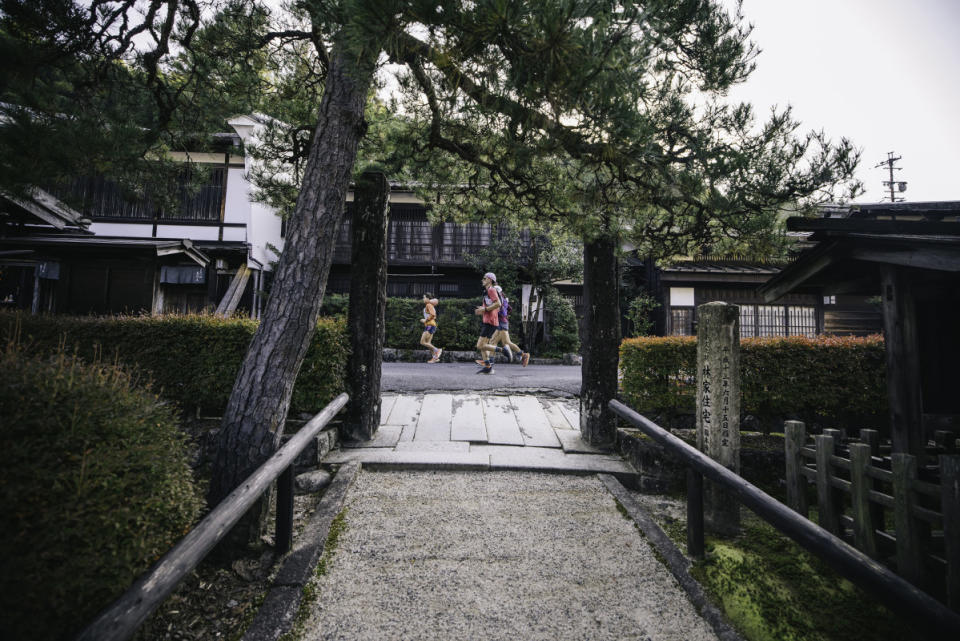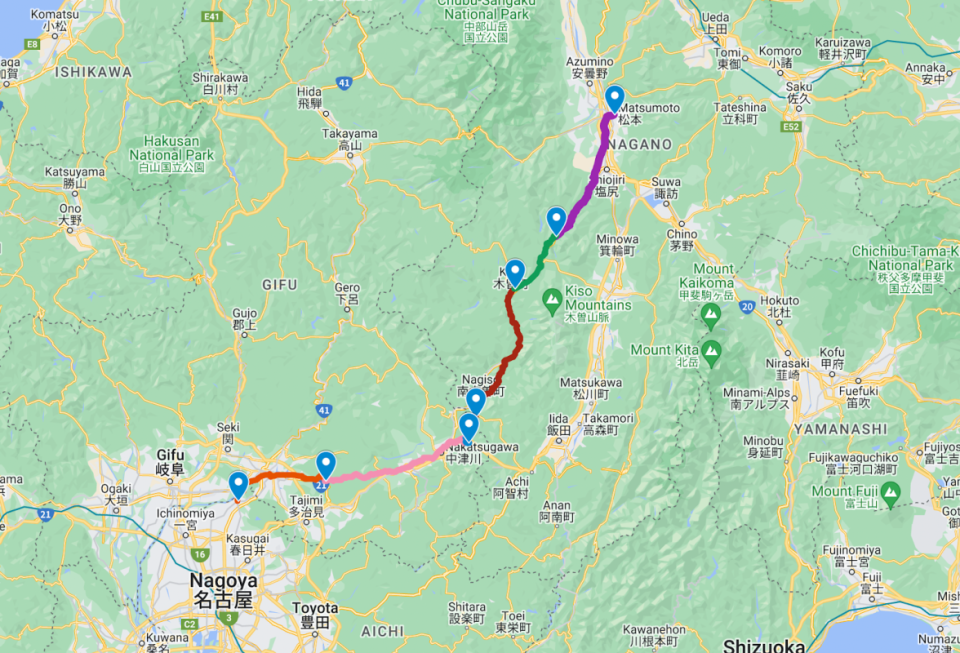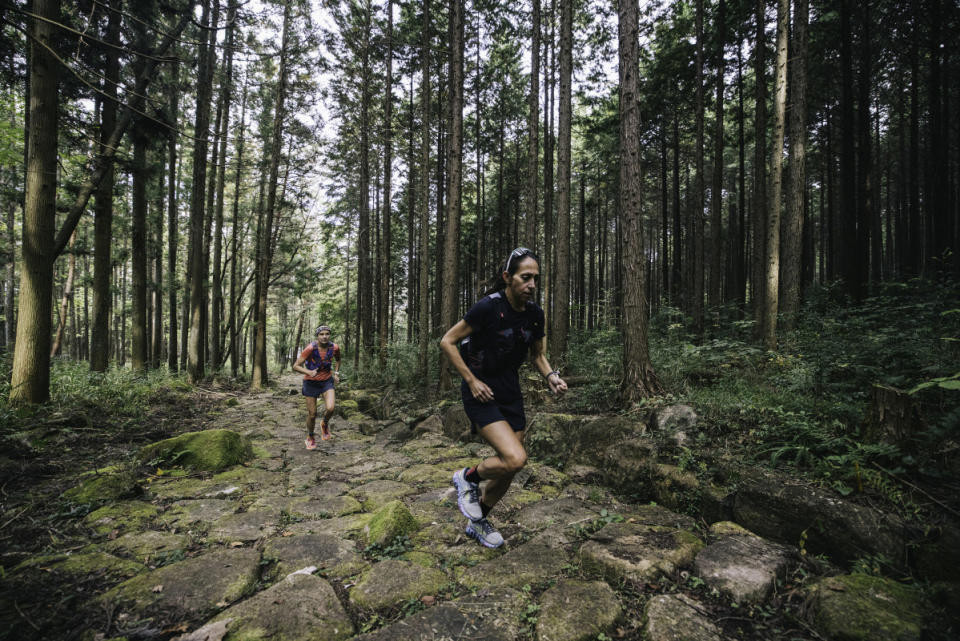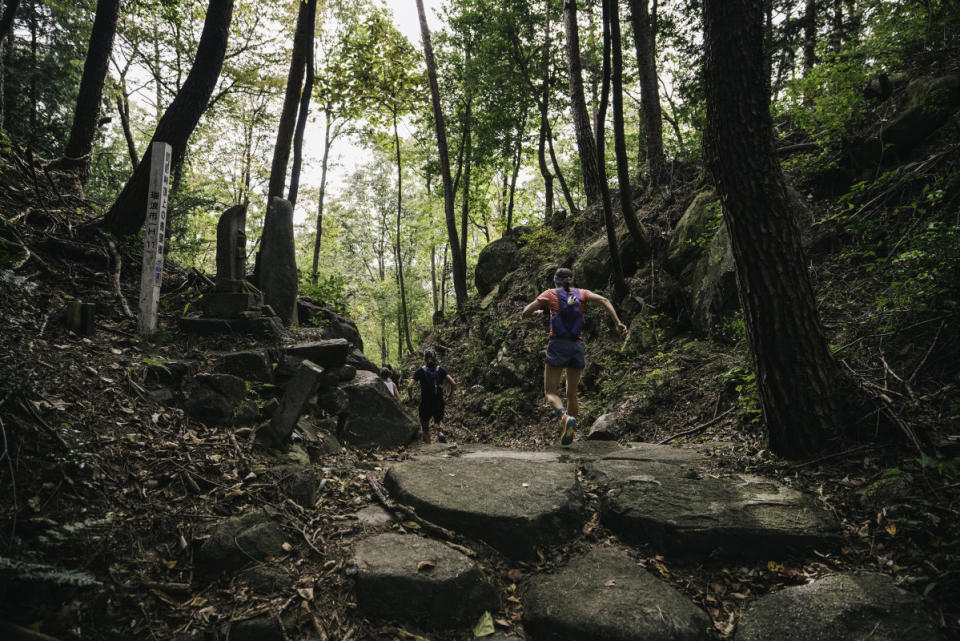Running 130 Miles Along Japan's Nakasendo Trail Is Like Traveling 400 Years Back in Time
Stuck at home during the pandemic, I began researching the best trails around the world, hoping I would get the opportunity to run them someday. While chatting with expat friends in Tokyo about the Kumano Kodo, a famous pilgrimage route in southern Japan, they tipped me off to a hidden gem, the Nakasendo Trail, a less-famous route that has just as much folklore and cultural importance, but without the crowds.
This sent me down an online rabbit hole to learn about this ancient road's history and a fever dream to put together an itinerary to run it with friends. The Nakasendo Trail is not known as an ultrarunning destination, but it has all the pieces of a perfect trip: big mountains, traditional inns to stay at, shuttle services for luggage, and amazing trails.
Fast forward three years (Japan took longer than most countries to reopen its borders) and I’m sitting around a communal table inside Oginoya, a traditional restaurant in Japan's Kiso Valley, realizing my dream is a reality. This is our second to last day running the Nakasendo Trail. It's easy to overlook how much work and patience went into getting here, so I relish that fact while slurping ramen and sipping matcha tea.
But let me backtrack and give you more context about this incredible place.
Nakasendo's Storied History
The Nakasendo Trail is an ancient route that runs across the Japanese Alps and served as a vital connection between Kyoto and Edo (present day Tokyo). The term "Nakasendo" translates to "central mountain route," a nod to the challenging terrain it traversed. Established by the Tokugawa shogunate in the early 1600s, it helped facilitate political and cultural exchanges during a time Japan was marked by strict feudalism.
The Nakasendo became a lifeline for travelers, merchants, and pilgrims, fostering economic development and cultural exchange between the regions it linked. Traveling along the Nakasendo Trail was quite the journey, often taking three weeks from end-to-end.

Andy Cochrane
The route is dotted with post towns, known as juku, which served as resting places for weary travelers. Notable juku including Magome, Tsumago, and Narai have been remarkably well-preserved, with wooden buildings and vibrant culture. These “open-air museums” allow visitors to experience the Nakasendo Trail as it was in the Edo period, 400 years ago.
The folklore of the Nakasendo runs deep, with stories about samurai, merchants, and everyday people who traversed its path. However, much of the actual trail was covered during the Meiji era in the late 1800s, when Japan embraced modernization.
As railways expanded, post towns faced a steady decline. In recent decades, there's been a renewed interest in revitalizing the historic route. Today, sections of the Nakasendo Trail are becoming popular hiking trails, acting as a tangible link to Japan's history.

Andy Cochrane
Best Time to Hike or Run the Nakasendo Trail
We chose to visit in October to see the beautiful fall colors, which I would highly recommend. Rain is quite common during the fall months, although we didn’t get our first heavy rain until the very end of the trip.
The southern Japanese Alps aren’t terribly high in elevation. We topped out at just above 4,000 feet—but they do catch more weather than the lowlands. If you plan to run or hike in this section, be prepared for cooler temps, wind, and precipitation.
Summer is the busiest season on the Nakasendo, and iconic post towns like Magone, Tsumago, and Narai are the most popular spots. All three are still worth visiting, but be aware that you'll be around a lot of other tourists. It's like visiting one of the best national parks in the U.S. during the busy season.
How to Run the Nakasendo Trail
The Nakasendo is rarely known outside the country—especially compared to the Kumano Kodo, a UNESCO World Heritage Site—but that doesn’t make it impossible to plan a multi-day trip. We built our itinerary around two things: mountain trails and the most preserved post towns. Here’s a quick snapshot of our route.
Example Nakasendo Itinerary:
Run 20 miles to Tsubashi
Run 30 miles to Magome
Run 7 miles to Tsumago
Run 30 miles to Fukushima
Run 18 miles to Narai
Run 25 miles to Matsumoto

Courtesy of Andy Cochrane
As an avid long-distance runner, this six-day, 130-mile route from Nagoya to Matsumoto allowed us to see a lot in just a week, while getting to experience the culture by staying at traditional inns and onsens at night. This is the best-preserved section of the Nakasendo as well as the most scenic, crossing over the Japanese Alps.
The process wasn’t easy; there aren’t easy to find GPX or KML files online, let alone a website with info to help plan a trip. After a lot of homework, I cobbled together our itinerary, hoping my Japanese translations were correct and using some of the prefecture websites. Our route ended up being a mix of trails, rural roads, streets, and highways, because most of the original trail is covered by modern infrastructure.

Andy Cochrane
Then came the fun part—putting together a group fit for this type of adventure. As a photographer who has shot with pro athletes for years, I’m lucky to call many of them close friends. This trip wasn’t a media event or race, but did require a high level of fitness. Magda Boulet, a U.S. Olympian and longtime friend, helped rally an all-star group with me. She invited Des Linden, another Olympic and pro marathoner, and I rallied Tim Tollefson and Ruth Croft, two of the top ultrarunners in the world right now.
Together, we booked international flights, rail passes, and our nightly accommodations (our favorites were Hanaya and Minshuku Kato). To average 20 miles each day, we hired a luggage shuttle service, Yamato Transport, to move our bags daily, which allowed us to run just the basics, like snacks, layers, and first aid.

Andy Cochrane
Then came the fun part—actually running it. As we learned, the trail is well marked in popular sections, like between Tsumago and Magome, and almost non-existent in other areas.
This required navigation skills using an app like Gaia Maps and accepting that we would get turned around once in a while. Sometimes these mistakes lead us to fortuitous moments, like our lunch at Oginoya. Each day we passed by tea houses, temples, and shrines—our favorite was the one on the top of Torii Pass. More than once we felt like we were transported back in time.
Why You Need to Visit
If you’re just looking for the best trails to run in Japan, you should probably skip the Nakasendo. There are beautiful stretches with lust forests, cobbled paths, and mountain views, but these are the minority. A lot of the Nakasendo is on backroads, past rural communities, farms, and small towns. However, if you’re looking for a running experience with history below your feet, you should look no further.
There are very few places in the world you can run on an ancient footpath, just as travelers did centuries ago. Where you can eat traditional foods, sleep inside inns with basic amenities, take short classes on the history and food, and soak in onsens to recover from long days on your feet. This is all possible on the Nakasendo, it just takes a little planning and a good group to pull it off.
Men’s Journal aims to feature only the best products and services. We update when possible, but deals expire and prices can change. If you buy something via one of our links, we may earn a commission.

Courtesy Image
Essential Gear to Run Nakasendo Trail
Hybrid Shoes
While most of the Nakasendo Trail is road, the stretches of trail you do get are steep, often wet, and loaded with cobblestones. The best shoe for a trip like this is a hybrid for road and trail running, with plenty of support and cushioning for long miles. I ran the entire way in the Nike UltraFly, which has a big stack, carbon plate, and durable upper that can handle anything thrown at it.
Multipurpose Jacket
Layering is crucial for long days, as morning temps start chilly but heat up quickly. I relied on the Arc’teryx Delta Hybrid Hoody for warmth and Norvan Shell Jacket to keep me dry when it was raining. Both breathe well enough to wear for long, steady miles. When I wasn’t using them, I would quickly stuff them in my pack, both taking up very little space.
Running Pack
As a photographer, I typically run with my camera, plus spare clothes, a first aid kit, and snacks to get me through long days. Thus, I almost always opt for larger running packs. The downside is that they almost almost bounce up and down, but the Patagonia Slope Runner Vest is the exception. It can carry up to 18 liters while sitting securely on my back with a simple yet innovative design.

